It’s Sunday. I’m standing in the grocery store chatting with a fellow gym rat. We’re on the same schedule. Gym first. Groceries second. Topic of discussion? The vaccine. Consensus? Neither of us planned on getting it.
It’s the following Saturday. I’m walking out of the hospital clinic having gotten my first dose of the vaccine.

When I was a kid, we got suckers after we got a shot. As an adult, all I got was a bandaid.
“You did WHAT?!”
“I got my first dose of the vaccine.”
“Wait a minute. You’re a massage therapist. Aren’t you supposed to be into all that natural stuff? You know – herbs, natural approaches, incense, chanting, juicing – you know. All that stuff natural people use to protect themselves from a bug.”
This has pretty much been people’s reaction to me personally getting the vaccine. That’s not counting the additional spiritual and political arguments I encountered as to why I should avoid it.
“Besides that, you said you didn’t want to get it. What changed?”
What changed indeed. During that conversation on Sunday, I had no intention of ever getting the vaccine until I said the following words. “I think I’m afraid of it because I don’t understand it.” There it was. My red flag. In my own words, I was letting fear and not facts rule my decision-making process. Fear that was driven by what the masses were saying on social media who had fallen prey to uneducated viewpoints. Suddenly I was hungry to know the facts.

Vesper demonstrates the average human’s reaction to reading research studies.
I love to research. I love facts. Problem is that solid research and facts are usually embedded in dry, boring reading. The average human being’s eyes would glaze over and pass out from sheer boredom before comprehension could kick in. Said human would sleep great but wouldn’t have gleaned anything useful beyond the extra z’s. Fortunately for me I like the challenge of working my way through the snooze fest because what I learn in the end is so exciting! Call me weird. It’s my geekism and I embrace it.
My goal with this series is to explain to you in simple language what I learned. This is NOT an attempt to change how you feel about getting a vaccine or sway your opinion about it. I will not be delving into the politics and spiritual arguments that surround this. This is strictly talking about the science in all the avenues that concern the human body. The goal here is to explain how both the body and the vaccine works and eventually, after what I learned, why I chose to get vaccinated (and it’s not because I was afraid of getting COVID-19).
This series is in three parts. Vaccination – Part 1: Basic Anatomy, Vaccination – Part 2: The mRNA Vaccine, and Vaccination – Part 3: Why I Did It. There’s a lot of information here and it would be cruel to ask you to read through it all in one sitting no matter how entertaining my writing may be. Besides, you might want to digest each part prior to moving to the next.
 In researching this, I decided to deliberately steer clear of information that has been recently released and stick to older clinical studies that predated the pandemic as well as basic high school anatomy and physiology. I figured that way I’d reduce the chance of being influenced by pro or con arguments and therefore capable of making my own educated decisions. I have included all of my references at the end of this article. Although there are some 2020 based references, those were used to glean information regarding the present vaccine and were not used to lay the foundation for my basic education on the various questions this whole debate had sparked for me.
In researching this, I decided to deliberately steer clear of information that has been recently released and stick to older clinical studies that predated the pandemic as well as basic high school anatomy and physiology. I figured that way I’d reduce the chance of being influenced by pro or con arguments and therefore capable of making my own educated decisions. I have included all of my references at the end of this article. Although there are some 2020 based references, those were used to glean information regarding the present vaccine and were not used to lay the foundation for my basic education on the various questions this whole debate had sparked for me.
Before I could delve into the vaccine, I wanted to go back and review the basics of human anatomy as well as viral anatomy. I mean come on. If you don’t know how your body or a virus works in the first place, trying to wrap  your head around what you’re going to put into it isn’t going to make any sense.
your head around what you’re going to put into it isn’t going to make any sense.
What I noticed with social media, web articles, etc. is that they pretty much skipped these basics and assumed all of us remembered our high school biology. I don’t know about you but I’ve slept since then (and probably even in that class). Sure, we’ve all heard terms like RNA, mRNA, innate immunity, adaptive immunity, virus, spike protein, lipids, and vaccine, but the truth is that all we can remember about them is just enough to be dangerous to our understanding and not well-versed enough to be reliable.
 So back to the buzzwords. I kept hearing about RNA and mRNA, innate and adaptive immunity and spike proteins that were somehow associated with this virus thing. These all were supposed to work together but I needed to know how they worked on their own first. I had to remind myself of my basic biology:
So back to the buzzwords. I kept hearing about RNA and mRNA, innate and adaptive immunity and spike proteins that were somehow associated with this virus thing. These all were supposed to work together but I needed to know how they worked on their own first. I had to remind myself of my basic biology:
- I know I have RNA in my body but what is RNA and what does it do?
- How does my immunity work to protect me?
- What are the spike proteins of a virus and how does a virus work?
Only after those questions were answered could I reliably evaluate:
- How does this all work with the vaccine?
Without further ado, let’s get started!
What is RNA and what does it do?
Ah, the cell. There are millions of them in our bodies. They are tiny little factories helping our body constantly carry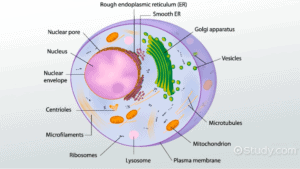 out the activity needed for our bodies to live. A single cell has several elements within it but we’re going to concentrate on the RNA components.
out the activity needed for our bodies to live. A single cell has several elements within it but we’re going to concentrate on the RNA components.
You are probably already well aware that DNA is our body’s blueprint. Written on that blueprint is everything special about you and only you. Your DNA is what identifies you as you and no one (or no-thing) else.
We are constantly renewing and functioning. In order to do this, my body needs access to this DNA blueprint in order to manufacture more of me. But the DNA can’t leave the cell’s nucleus in order to do this. It has to stay safely locked away 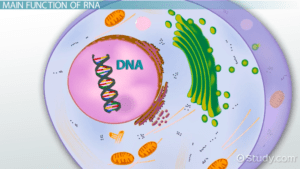 so it can’t be damaged.
so it can’t be damaged.
Think of DNA as Grandma’s prized and cherished cookbook. Within this cookbook are all of the recipes on how to make every element of you. You’re not allowed to take that cookbook out of Grandma’s kitchen BUT she will let you copy a recipe from it.
So how can I make more of myself if I can’t use the actual blueprint (cookbook)? Enter RNA.
The job of RNA is to create the amino acids that will be used to build proteins. These proteins will be used as the building blocks to build everything our bodies need to exist, from the hemoglobin in our blood to the keratin in our fingernails. Although RNA is normally spoken of with just the moniker RNA, there isn’t just one RNA. In this scenario, RNA refers collectively to a team of three types of RNA and they all work together in our cells to help our bodies create what they need to live.
This team of RNA is comprised of:
- Messenger RNA or mRNA
- Transfer RNA or tRNA
- Ribosomal RNA or rRNA
(Don’t get too hung up on the names. We’re going to break this down into their simple explanations.)
Each of these RNA team members plays one particular role in assembling the amino acids that will be used to construct a protein.
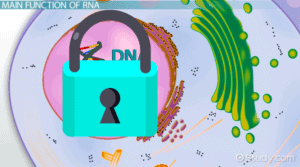

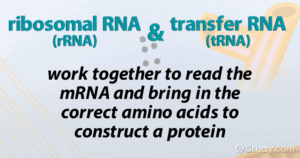
mRNA is a copy of a section of your DNA. Remember that Grandma’s prized cookbook (DNA) can’t leave her  kitchen (has to stay locked away in the nucleus for safekeeping). But you want to bake her special cookies (let’s say your body wants to create more hemoglobin – mmmm hemoglobin cookies…). mRNA will make a copy (transcription) of the recipe (“recipe” of that segment of your DNA) and then take that out of the nucleus and into the power plant area of the cell where the other two RNA team members are waiting to go to work (translation).
kitchen (has to stay locked away in the nucleus for safekeeping). But you want to bake her special cookies (let’s say your body wants to create more hemoglobin – mmmm hemoglobin cookies…). mRNA will make a copy (transcription) of the recipe (“recipe” of that segment of your DNA) and then take that out of the nucleus and into the power plant area of the cell where the other two RNA team members are waiting to go to work (translation).
 tRNA is like the Shipt shopper. It’s the grocery-getter. tRNA reads what’s on the mRNA’s recipe card and gathers the ingredients needed to construct those amino acids which in turn will be used to construct a protein.
tRNA is like the Shipt shopper. It’s the grocery-getter. tRNA reads what’s on the mRNA’s recipe card and gathers the ingredients needed to construct those amino acids which in turn will be used to construct a protein.

rRNA is the chef. It assembles the ingredients gathered by tRNA into the amino acids needed for the protein as it is outlined on the mRNA recipe card.
The end result are the appropriate amino acids that will be used to construct a protein. This team works tirelessly to make these constructs for protein after protein building blocks in order to build hemoglobin or whatever it is that your body needs for it to function.
RNA doesn’t work indefinitely on this task. Just like anything in your body, its lifespan is limited. Depending on what the recipe is being transcribed (some recipes are just more detailed than others), human mRNA lifespans can range as short as 30 minutes to as long as 24 hours (averaging about 10 hours). After creating several batches amino acids with its team members, mRNA‘s cycle of life is completed. Natural degradation will ensue and the remnants of mRNA are eliminated from the body.
REVIEW
Q: What is RNA and what does it do?
A: My body already has a team RNA
mRNA – the recipe
tRNA – the grocery-getter
rRNA – the chef
They interact in order to make the amino acids that will be used to build the proteins my body will use to build more of me. Once their lifecycle is complete, they will naturally degrade and be eliminated from my body.
How does my immunity work to protect me?
Immunity is the body’s ability to recognize self from non-self. Your particular protein arrangement is unique to you. Remember that DNA cookbook and the RNA team? You are constructed of proteins that were copied from that cookbook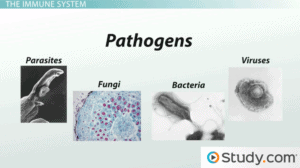
In a healthy body, your Immune System deals with invaders. Parasites, fungi, bacteria, viruses, and environmental contaminants are all visitors that can raise a red flag with the Immune System because they also are not “you.”
There are two types of immunity we all possess. Innate Immunity and Acquired Immunity. They are the soldiers in your body that protect you.
Innate Immunity is the immunity you were born with. Innate Immunity requires no special training in order to spring into action. Your skin is actually part of this along with special cells inside your body. Your skin helps protect the 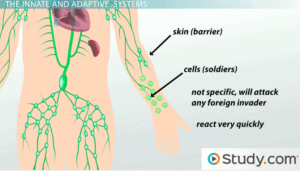 inner workings of you from all exterior invaders you come into contact with on a daily basis. Should something manage to breach the skin, you have several types of cells hell bent on attacking the contaminant as soon as it passes that barrier. They don’t hesitate. Their standing orders are “shoot to kill” any invader. Think about scraping your knee. Bacteria from the sidewalk you just fell on can now pass through the skin but then the cells take over the fight and destroy the bacteria before it can cause significant damage. These cells don’t discriminate. If it’s foreign from your DNA makeup, Innate Immunity will seek to eradicate it.
inner workings of you from all exterior invaders you come into contact with on a daily basis. Should something manage to breach the skin, you have several types of cells hell bent on attacking the contaminant as soon as it passes that barrier. They don’t hesitate. Their standing orders are “shoot to kill” any invader. Think about scraping your knee. Bacteria from the sidewalk you just fell on can now pass through the skin but then the cells take over the fight and destroy the bacteria before it can cause significant damage. These cells don’t discriminate. If it’s foreign from your DNA makeup, Innate Immunity will seek to eradicate it.
Your Adaptive Immunity is acquired. It actually has to encounter an invader (a.k.a. antigen) in order to spring into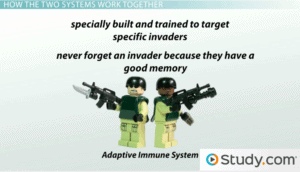 action. It learns how to defeat the antigen and then trains other members of your Adaptive Immunity army on how to do the same. This creates a whole army of Adaptive Immunity soldiers to fight in the invasion battle (you may have heard of them referred to B & T cells). Once they learn how to defeat the invader, they never forget. They remember the skills and battle plan they used the last time to win and employ that strategy again should the invader ever come back.
action. It learns how to defeat the antigen and then trains other members of your Adaptive Immunity army on how to do the same. This creates a whole army of Adaptive Immunity soldiers to fight in the invasion battle (you may have heard of them referred to B & T cells). Once they learn how to defeat the invader, they never forget. They remember the skills and battle plan they used the last time to win and employ that strategy again should the invader ever come back.
“So why does the body have two versions of immunity? You said the Innate Immunity was a badass ‘shoot to kill’ fighter. That’s my kind of defender! Why would I need anything else?”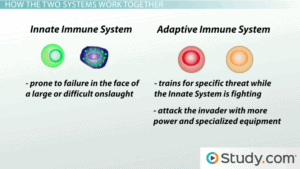
Well, they work together using their special talents. Although your Innate Immunity is on alert as soon as an invader is encountered and goes to work defending your body, it is easily overwhelmed in the case of a mass invasion, so to speak. Like any good soldier, they’ll hold the fort as long as they can while the Adaptive Immunity sends troops for specialized training. Once the Adaptive Immunity army is armed appropriately, they join the fight. Not only do they fight and win, but they also make careful notes of what the enemy looked like. Should he show up again, they will quickly identify him and take him out.
REVIEW
Q: How does my immunity work to protect me?
A: My immune system knows what’s me because my RNA built me from a copy of my DNA.
My immune system will attack and destroy anything that is not me and it will remember how it destroyed it. Should the invader ever return, my immunity will recognize it and kill it.
What are the spike proteins of a virus and how does a virus work?
 A virus is a tiny, infectious particle that lives inside of another living organism. A virus doesn’t eat, breathe, or move on its own and its only job is to make copies of itself. But it can’t do that without making you help it. (If that doesn’t just sound like a creepy concept for a horror movie, I don’t know what does.)
A virus is a tiny, infectious particle that lives inside of another living organism. A virus doesn’t eat, breathe, or move on its own and its only job is to make copies of itself. But it can’t do that without making you help it. (If that doesn’t just sound like a creepy concept for a horror movie, I don’t know what does.)
Let’s look at the anatomy of a virus so we can understand how it does its dirty work. A virus has a center cargo of genetic material – either a DNA or RNA center. A few of the DNA viruses you’ve heard of include such nasty buggers as herpes, smallpox, hepatitis, and warts. Other viruses you’ve heard of that have a RNA center would include HIV, SARS, influenza, polio, rabies, zika, measles, and our infamous COVID-19 version. Back to the anatomy.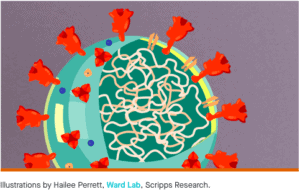
This inner genetic core (that’d be those white and beige squiggles) is surrounded by an outer shell (shown in light blue) that is made of fats that protect this inner cargo. Many viruses (like COVID-19) also develop spike proteins (shown in red) that make the organism look like a mace a warring knight would wield. These spikes act like grappling hooks.
But if it can’t move, how does it even get inside you to do its dirty work? It does this is via exposure. Exposure can occur through a cut in the skin, injected like a mosquito bite, or mucous membranes such as those in the eyes, nose, mouth, or sexual organs.
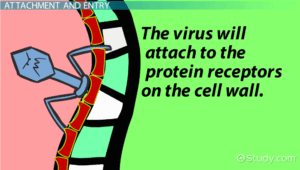 Once the virus gets into the body and starts floating around, the next thing it does is encounter and attach itself to a cell. Remember that normally our cells are little power plants that are constantly helping our bodies renew themselves and carry out various functions. Your cells are exactly what a virus needs to reproduce itself. Without that valuable little factory, the virus can’t replicate.
Once the virus gets into the body and starts floating around, the next thing it does is encounter and attach itself to a cell. Remember that normally our cells are little power plants that are constantly helping our bodies renew themselves and carry out various functions. Your cells are exactly what a virus needs to reproduce itself. Without that valuable little factory, the virus can’t replicate.
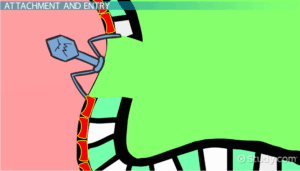 Using its spike proteins, a virus will attach itself to the protein receptors on your cell. Once it’s attached, it’s game on. This ornery little devil will make a hole in the cell and get inside. If you think about it, those spike proteins are probably the most dangerous thing about the virus outside of the genetic cargo it carries. Without the spike proteins, the virus can’t get into your cells to reproduce! Once inside, it will hijack this cell’s tiny power plant to make copies of itself rather than the cell making something that is meant to support the helpful functions for your body.
Using its spike proteins, a virus will attach itself to the protein receptors on your cell. Once it’s attached, it’s game on. This ornery little devil will make a hole in the cell and get inside. If you think about it, those spike proteins are probably the most dangerous thing about the virus outside of the genetic cargo it carries. Without the spike proteins, the virus can’t get into your cells to reproduce! Once inside, it will hijack this cell’s tiny power plant to make copies of itself rather than the cell making something that is meant to support the helpful functions for your body.  These newly copied viruses find new cells in your body and start doing the same process all over again!
These newly copied viruses find new cells in your body and start doing the same process all over again!
REVIEW
Q: What are the spike proteins of a virus and how does a virus work?
A: A virus uses spike proteins like grappling hooks to grab my cells and hang on so it can gain entry to my cells. Once inside my cells, it uses the cell’s power plant to make copies of itself. These copies will seek out more of my cells to do the same.
Hopefully as you see the questions getting answered, you’re starting to get an idea where I’m going with this. I don’t know about you but once I understood these basics, I started to get really excited. So if you’re ready, grab yourself a refill on that beverage and snack and head on to Vaccination – Part 2: The mRNA Vaccine!
**Please note that I am in excellent health. I have no known health issues or immune system impairments. Decisions regarding participating in vaccination were based on this fact. Please consult your physician prior to becoming vaccinated if you presently have or suspect you may have health issues. This series should in no way be considered a substitute for the advice of your current medical practitioner.
Special Thanks
A series such as this one was extremely challenging to write. Thank you so much to everyone who helped provide feedback and encouragement. Special thanks to advance reader, friend, and bookworm extraordinaire, Elizabeth Robinson who helped keep my grammar in line. Thank you Jon Cooper (a.k.a. The Web Wizard), my web guy who suggested that I split the article into a 3 part series when I hit the 3200 word mark (and I wasn’t finished with the first section yet)! Also a most sincere thank you to the medical professionals and researchers who advised me. It was my concern that the information presented here be accurate. Their input helped insure that my examples and simplifying of concepts still accurately portrayed the science being discussed. They also helped cite areas in need of clarification. For this guidance, sincere thanks goes out to Joe Adams, Strategic Business Development at Life Omic, Andy Demofonte, PharmD, Gary Fourman R.Ph., Lilly & Co. (retired), Paul Joseph Halter III, MD, and Devon Hensel MS, Ph.D. I couldn’t have done it without you!
Sources
- https://www.nature.com/articles/nrd.2017.243?fbclid=IwAR1JAUhIbmkkc-89l76_oqYI500i4YikDWY77m2_onFSmGJTkxLBRksqPLw#Glos5
- https://study.com/academy/lesson/lytic-cycle-of-a-virus-definition-steps-quiz.html
- https://study.com/academy/lesson/lysogenic-cycle-of-a-virus-definition-steps-quiz.html
- https://www.goodrx.com/blog/ingredients-covid-19-vaccine/
- https://www.livescience.com/coronavirus-spike-protein-structure.html
- https://study.com/academy/lesson/viruses-lesson-for-kids-definition-facts.html
- https://www.ncbi.nlm.nih.gov/books/NBK8174/
- https://study.com/academy/lesson/role-of-rna-molecules-definition-functions.html
- https://www.nature.com/articles/s41586-020-2639-4
- https://www.phgfoundation.org/briefing/rna-vaccines
- http://sitn.hms.harvard.edu/flash/2015/rna-vaccines-a-novel-technology-to-prevent-and-treat-disease/
- https://www.scripps.edu/covid-19/science-simplified/parts-of-a-coronavirus/index.html
- https://study.com/academy/lesson/what-is-the-immune-system-our-bodys-defense-against-pathogens.html
- https://www.youtube.com/watch?v=3pFQpiawX80
- https://www.ncbi.nlm.nih.gov/books/NBK21523/
- https://study.com/academy/lesson/replication-of-dna-viruses.html
- https://oxfordmedicine.com/view/10.1093/med/9780198737773.001.0001/med-9780198737773-chapter-9
- https://www.nytimes.com/interactive/2020/health/moderna-covid-19-vaccine.html
- https://study.com/academy/lesson/role-of-mrna-in-protein-synthesis.html
- https://www.idsociety.org/covid-19-real-time-learning-network/vaccines/vaccines-information–faq/
- https://sciencing.com/degradation-mrna-6196816.html
- https://jamanetwork.com/journals/jama/fullarticle/2770485
- https://www.publichealthontario.ca/-/media/documents/ncov/vaccines/2020/12/covid-19-mrna-vaccines.pdf?la=en
- https://www.ncbi.nlm.nih.gov/pmc/articles/PMC5906799/


0 Comments